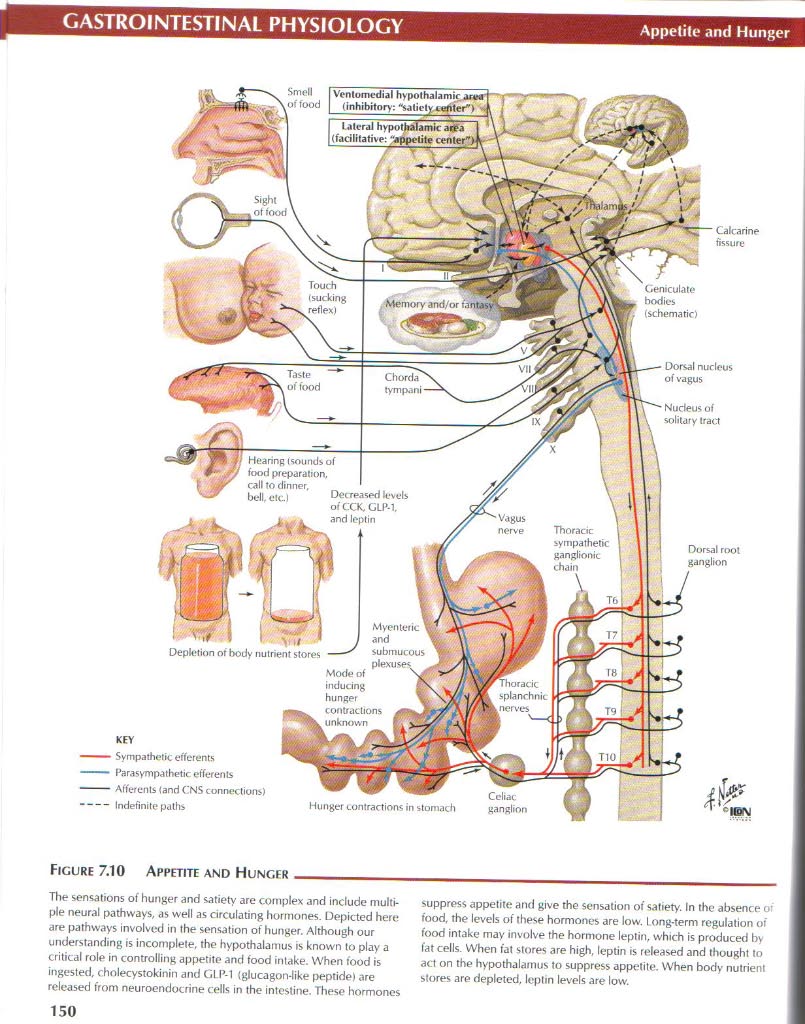netter132

GASTROINTESTINAL PHYSIOLOGY
Appetite and Hunger
Smell I Vcntomcdial hypothalami
.offood 1 ............ *
(inhibitory: Sjticly utfiterT
I Ijlcral hypollialamk JW.1
| (fadlHative: ^appolite center'
Touch
(sucking
reflex)
Memory and/or untasy'"
Geniculate
bodies
(scbematic)
Taste of food
Chorda tympanl -
■ Oorsal nurlfus of vagus
■ Nudeus of solilary iract
Hearing (sounds of
food preparation,
cali to dinner, _ ,,
beli elc I DecTeased k*vds
' of COC CLP-1.
Thoracic
sympathetłC
ganglionic
chain
Dorsal roi ganglion
ł ^ . and leptin
Depletion of body nutrient Stores
Myenteiic 1 and
submucous
Modę of
induting
hunger
contractions
unknown
Thoracic
splanchnic
.nerves
’NS connections)
Celiac
Hunger contractions in stornach ganglion
Figurę 7.10 Appetite and Hunger_
The sensations of hunger and satiety are complex and include multi-ple neural pathways, as well as drculating hormones. Depicted here are pathways involvcd in the sensation of hunger. Although our understanding is incomplele, the hypothalamus is known to play a critical role in controlling appetite and food intake. When food is ingested, chołecystokinin and GLP-1 (glucagon-like peptide) are released from neuroendocrine cells in the intesline. These hormones suppress appetite and give the sensation of satiety. In the absence o-food, the levels of these hormones are Iow. Long-term regulation of food intake may involve the hormone leptin, which is produced by fat cells. When lat Stores are high, leptin is released and thought to act on the hypothalamus to suppress appetite. When body nutrient Stores are depleted, leptin levels are Iow.
150
Wyszukiwarka
Podobne podstrony:
netter156 GASTROINTESTINAL PHYSIOLOGY Overvievv of Cii Trać! Fluid and Electrolyte Transport Ingest
47750 netter160 GASTROINTESTINAL PHYSIOLOGYAbsorption of Essential Elements and Vitamins Iron Elem
netter124 GASTROINTESTINAL PHYSIOLOGY Lowrr Esophageal Sphincter mm Mr Normal LES tonę is physiologi
netter140 GASTROINTESTINAL PHYSIOLOGY Smali Intestinc Structure: III Mitochondria Tight junctions ■
netter158 GASTROINTESTINAL PHYSIOLOGY Digestion of Carbohydrales Maftose Pancreatic amyiase
netter130 GASTROINTESTINAL PHYSIOLOGY Major Cl Hormones LEGEND Thick linę indicatcs prinwry action T
netter154 GASTROINTESTINAL PHYSIOLOGY Bilirubin Excretion Hemoglobin IndirecHeacting bilirubin
netter183 ENDOCRINE PHYSIOLOGY Gonad and Genital Duet Formation (pulled aside) I .‘rogemtoi•y Testos
więcej podobnych podstron